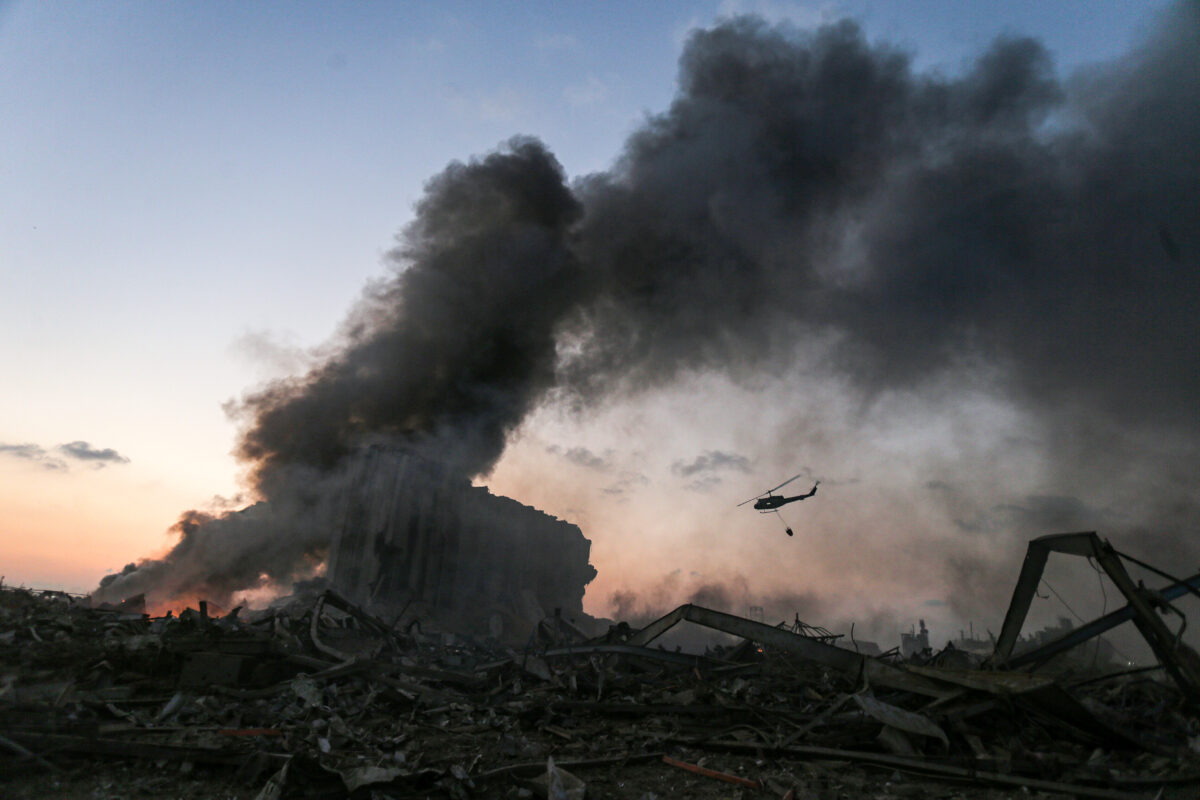
Throughout history, mankind has witnessed numerous catastrophic explosions that have left indelible marks on communities, landscapes, and the course of history itself. On August 4, 2020, a catastrophic explosion rocked the port area of Beirut, Lebanon, causing immense devastation to the city. At about 6:07 p.m. on August 4, 2020, a warehouse at the Port of Beirut containing large quantities of ammonium nitrate exploded, resulting in widespread damage for several kilometers. The blast killed at least 200 people, injured at least 6,000, and left an estimated 300,000 people homeless, including 80,000 children. Multiple medical facilities, including several major hospitals, sustained structural damage. Several hospitals were destroyed.
The massive 2020 Beirut port explosion, the summer 2021 fuel crisis, and the most recent cholera outbreak in the country highlighted the deeply rooted unfolding crisis and multiplied the needs of its suffering population. Global and regional developments, including the COVID-19 outbreak and more recently the impact of the Ukraine crisis and global economic deterioration, further impacted the situation. Lebanon also continues to manage the spillover from the Syrian crisis, and hosts the largest number of refugees per capita in the world.
The Beirut Port explosion was caused by the detonation of approximately 2,750 tons of ammonium nitrate that had been improperly stored in a warehouse for several years.
The impact of the explosion was far-reaching:
- According to the United Nations Development Programme, a total of 200,000 housing units were affected.
- The loss of homes and subsequent overcrowding of households, communities, hospitals and events including protests and funerals, contributed to a drastic increase in COVID-19 cases.
- Casualties: At least 218 people were killed, and around 6,500 others were injured. The loss of life and injuries led to widespread grief and a healthcare crisis in the city.
- Destruction: The blast caused extensive damage to buildings, homes, infrastructure, and businesses within a large radius of the port. It left an estimated 300,000 people homeless and caused economic losses in the billions of dollars.
- Humanitarian Crisis: The explosion exacerbated an already dire economic situation in Lebanon, leading to increased unemployment, poverty, and food insecurity.
- Political and Social Unrest: The incident further fueled public discontent and led to protests against government corruption and mismanagement.
- International Aid: The international community responded with aid and support to assist in relief and recovery efforts.
- Investigation: Following the disaster, there were demands for accountability, and an investigation into the circumstances surrounding the storage and handling of the ammonium nitrate was launched.
- Reconstruction: Rebuilding efforts have been ongoing, but the scale of destruction and the economic challenges have made the process difficult and time-consuming.
The explosion on August 4th, 2020, was amongst the deadliest in the history of mankind. This article delves into some of the biggest explosions in history, highlighting the impact they hadon the places in which they occurred.
- The Tunguska Event (June 30, 1908), Tunguska, Siberia, Russia
The Tunguska event is one of the most significant and mysterious explosions in recorded history. On June 30, 1908, a massive explosion, thought to be caused by the airburst of a meteoroid or comet, occurred over the remote Tunguska region in Siberia. The blast released an estimated energy equivalent of 5-15 megatons of TNT, flattening around 2,000 square kilometers of forest. Fortunately, due to the region’s remote location, there were no reported casualties. However, the shockwave from the explosion was felt across vast distances, causing fluctuations in atmospheric pressure and even lighting up night skies in Europe and Asia.
- Halifax Explosion (December 6, 1917), Halifax, Nova Scotia, Canada
- and 9,000 injured
During World War I, the SS Mont-Blanc, a French cargo ship loaded with high explosives collided with the Norwegian vessel SS Imo in the Halifax Harbor. This catastrophic accident triggered one of the largest non-nuclear explosions in history. The resulting explosion claimed approximately 2,000 lives and injured over 9,000 people. The blast was so powerful that it leveled the entire neighborhood of Richmond and caused significant damage to other parts of Halifax. The disaster brought international aid and marked a turning point in disaster response and prevention efforts.
- Texas City Disaster (April 16, 1947), Texas City, Texas, USA
- thousands injured
The Texas City Disaster ranks as one of the deadliest industrial accidents in U.S. history. On April 16, 1947, the SS Grandcamp, a cargo ship carrying ammonium nitrate fertilizer, caught fire in the Texas City port. The subsequent explosion, along with a chain reaction of other fires and explosions, caused widespread destruction. The explosion claimed the lives of approximately 600 people and injured thousands more. The incident led to improved safety regulations and handling procedures for hazardous materials in ports and industrial facilities.
- The Krakatoa Eruption (August 26-27, 1883), Krakatoa Island, Indonesia
The eruption of the Krakatoa volcano remains one of the most infamous volcanic explosions in history. On August 26-27, 1883, the cataclysmic event was heard as far as 3,000 miles away and caused an estimated death toll of 36,000 people. The eruption resulted in the destruction of two-thirds of the island, and the massive tsunamis generated by the event caused further devastation, hitting nearby coastal areas in Java and Sumatra. The explosion was so colossal that it had a significant impact on global climate patterns for several years.
- The Atomic Bombings of Hiroshima and Nagasaki (August 6 and 9, 1945), Hiroshima and Nagasaki, Japan
Among the most horrific and consequential explosions in history were the atomic bombings of the Japanese cities of Hiroshima and Nagasaki during World War II. On August 6, 1945, the United States dropped “Little Boy,” an atomic bomb, over Hiroshima, instantly killing an estimated 140,000 people. Three days later, on August 9, 1945, “Fat Man,” another atomic bomb, was detonated over Nagasaki, resulting in around 70,000 deaths. The bombings played a pivotal role in Japan’s surrender and the end of World War II, but the devastation and long-term effects of radiation have left a lasting impact on the affected regions and generations of survivors.
- Chernobyl Disaster (April 26, 1986), Chernobyl, Ukraine
The Chernobyl Nuclear Power Plant disaster is the worst nuclear accident in history. On April 26, 1986, during a routine safety test, reactor number four experienced a catastrophic explosion, resulting in a massive release of radioactive materials into the atmosphere. The immediate explosion and subsequent fires claimed the lives of two plant workers, but the long-term effects of radiation exposure have led to thousands of deaths and increased rates of cancer and other health issues among the affected population. The disaster also led to the evacuation and abandonment of the nearby town of Pripyat and the establishment of the Chernobyl Exclusion Zone, which remains largely uninhabitable to this day.
- The Port Chicago Disaster (July 17, 1944), Port Chicago, California, USA
The Port Chicago Disaster was a horrific munitions explosion during World War II. On July 17, 1944, at the Port Chicago Naval Magazine, two ships were being loaded with ammunition and explosives. The catastrophic explosion that followed killed 320 sailors and civilians, injured nearly 400 more, and caused massive destruction to the port. This tragic event highlighted the dangerous conditions and racial inequalities faced by the predominantly African American workforce assigned to handle explosives during the war.
- Oppau Explosion (September 21, 1921), Oppau, Germany
The Oppau explosion was a massive industrial accident that occurred at a BASF plant in Oppau, Germany. On September 21, 1921, approximately 4,500 tons of ammonium sulfate and ammonium nitrate fertilizer stored in a silo detonated, resulting in an enormous blast. The explosion killed more than 500 people and caused widespread damage to the surrounding area. The tragedy led to the development of safer storage methods for hazardous materials in industrial settings.
- The PEPCON Disaster (May 4, 1988), Henderson, Nevada, USA
The PEPCON disaster was a devastating explosion that occurred at the Pacific Engineering Production Company of Nevada (PEPCON). On May 4, 1988, a fire broke out at the plant, which produced ammonium perchlorate, a component used in rocket fuel and fireworks. The fire escalated, leading to an enormous explosion that killed two people, injured hundreds, and caused extensive damage to the nearby area, including the destruction of homes and businesses.
Maan Barazy is an economist and founder and president of the National Council of Entrepreneurship and Innovation. He tweets @maanbarazy.
The views in this story reflect those of the author alone and do not necessarily reflect the beliefs of NOW.








